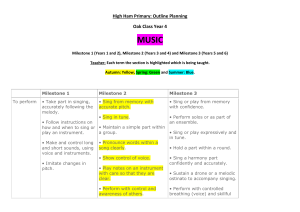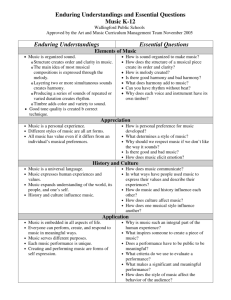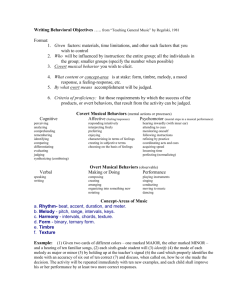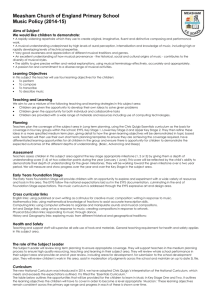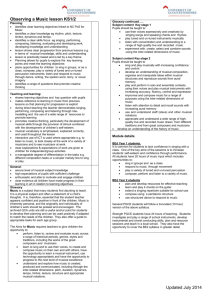Music Plan
advertisement
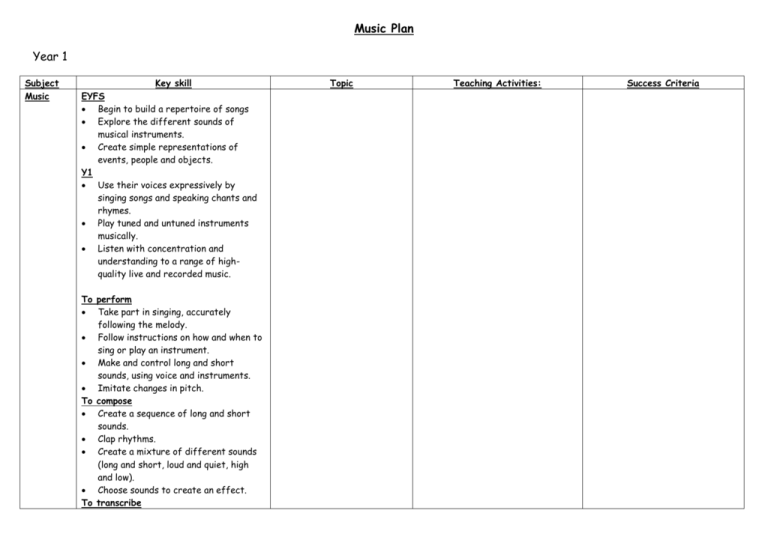
Music Plan Year 1 Subject Music Key skill EYFS Begin to build a repertoire of songs Explore the different sounds of musical instruments. Create simple representations of events, people and objects. Y1 Use their voices expressively by singing songs and speaking chants and rhymes. Play tuned and untuned instruments musically. Listen with concentration and understanding to a range of highquality live and recorded music. To perform Take part in singing, accurately following the melody. Follow instructions on how and when to sing or play an instrument. Make and control long and short sounds, using voice and instruments. Imitate changes in pitch. To compose Create a sequence of long and short sounds. Clap rhythms. Create a mixture of different sounds (long and short, loud and quiet, high and low). Choose sounds to create an effect. To transcribe Topic Teaching Activities: Success Criteria Use symbols to represent a composition and use them to help with a performance. To describe music Identify the beat of a tune. Year 2 Music To Perform Take part in singing, accurately following the melody. Follow instructions on how and when to sing or play an instrument. Make and control long and short sounds, using voice and instruments. Imitate changes in pitch. To compose Choose sounds to create an effect. Sequence sounds to create an overall effect. Create short, musical patterns. Create short, rhythmic phrases. To transcribe Use symbols to represent a composition and use them to help with a performance. To describe Recognise changes in timbre, dynamics & pitch Year 3 Music To Perform Sing from memory with accurate pitch. Sing in tune. Pronounce words within a song clearly. Show control of voice. Play notes on an instrument with care so that they are clear. To Compose Compose and perform melodic songs. Use sound to create abstract effects. Create repeated patterns with a range of instruments. Create accompaniments for tunes. To Transcribe Devise non-standard symbols to indicate when to play and rest. Recognise the notes EGBDF and FACE on the musical stave. To Describe Use the terms duration, beat, tempo, texture to describe music Evaluate music using musical vocabulary to identify areas of likes & dislikes Year 4 Music To perform Maintain a simple part within a group. Perform with control and awareness of others To Compose Choose, order, combine and control sounds to create an effect. Use digital technologies to compose pieces of music. Use drones as accompaniments. To Transcribe Recognise the symbols for a minim, crotchet and semibreve and say how many beats they represent. To Describe Use the terms: Timbre Pitch Silence Understand the layers of sound and discuss their effects on mood and feelings Year 5 Music To Perform Sing or play from memory with confidence. Perform solos or as part of an ensemble. Sing or play expressively and in tune. Hold a part within a round. To Compose Create songs with verses and a chorus. Create rhythmic patterns with an awareness of timbre and duration. Combine a variety of musical devices, including melody, rhythm and chords. To Transcribe Use the standard musical notation of crotchet, minim and semibreve to indicate how many beats to play. Read and create notes on the musical stave. To Describe Choose from a wide range of musical vocabulary to accurately describe and appraise music including: • pitch (high / low) • dynamics (loud/soft) • tempo (Fast/slow) • timbre (Timbre is what makes a particular musical sound different from another, even when they have the same pitch and loudness. For instance, it is the difference between a guitar and a piano playing the same note at the same loudness. • texture (thick sound – e.g. orchestra/ thin sound e.g. single instrument) • lyrics and melody (words and tune) • expressive (music played showing features of an emotion, idea or quality) • solo (a singer or instrumentalist playing a melody) • rounds (a voice or instrument copies what has just been played by another) • accompaniments (an additional part which supports or enhances another) Year 6 Music To Perform Sing a harmony part confidently and accurately. Sustain a drone or a melodic ostinato to accompany singing. Perform with controlled breathing (voice) and skillful playing (instrument). To Compose Thoughtfully select elements for a piece in order to gain a defined effect. Use drones and melodic ostinati (based on the pentatonic scale). Convey the relationship between the lyrics and the melody. Use digital technologies to compose, edit and refine pieces of music. To Transcribe Understand the purpose of the treble and bass clefs and use them in transcribing compositions. Understand and use the # (sharp) and ♭ (flat) symbols. Use and understand simple time signatures. To Describe Choose from a wide range of musical vocabulary to accurately describe and appraise music including: o Sense of occasion (Appropriate style of music played at a special or important event.) o harmonies (where several notes or chords come together to create a certain sound) o Combination of musical elements o Cultural context. Describe how lyrics often reflect the cultural context of music and have social meaning. o drones (A bass note held throughout a passage of music. A sustained note. A feature of Indian music) o cyclic patterns (repeating rhythmic patterns e.g. West African music)
